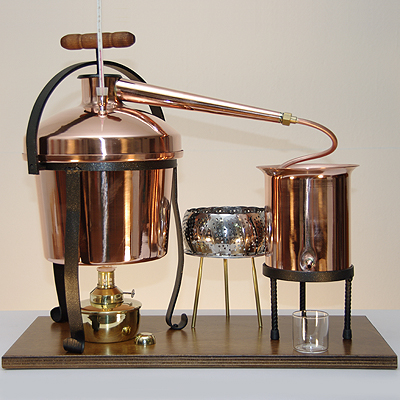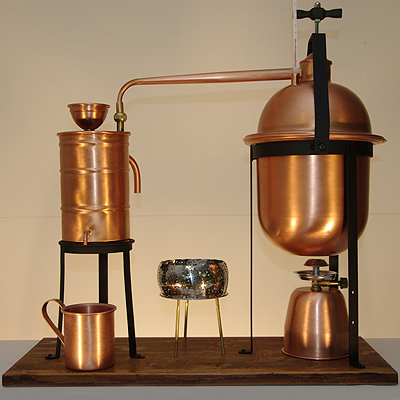 English
English Deutsch
Deutsch
 Distilling Alcohol at Home
Distilling Alcohol at Home
Shop: Alcohol Stills, Copper Moonshine Stills, Home Distiller’s Equipment – DFS Schmickl
All you need for distilling alcohol at home!
Alcohol Stills and Copper Moonshine Stills: Six Rules to Buy or to Construct an Alcohol Still by Yourself
- An alcohol still should be equipped with a steam thermometer, otherwise the still cannot be used appropriately to distill alcohol. Without a thermometer the heads and tails cannot be separated accurately with ease.
- Position of the steam thermometer: The alcohol content of the steam and thereby the temperature of the steam depends on the difference in height to the surface of the boiling mash. Thus only the temperature of the steam at the highest point of the still correlates to the alcohol content of the distillate. So the thermometer has to be mounted at the highest point of the alcohol still. The steam must flow around the measuring point of the thermometer, this is the case just below the turnoff to the condenser. After the temperature measurement the steam pipe shouldn’t rise further. If you mount the thermometer far below the highest point of the vapor, you will measure wrong temperatures, the discrepancy can be 10 °C or even more.
- The steam pipe’s diameter of the still shouldn’t be too small in relation to the volume of the still. The thinner and longer the pipe, the higher the pressure in the kettle while distilling. Even a small interior excess pressure results in a considerable change of the steam temperature and a wrong temperature measurement. Furthermore, an interior excess pressure results in losses of flavor.
- All materials of the still should not interact with the vapor or distillate. For example, don’t use rubber seals or a rubber hose, because rubber is not resistant against chemical solvents like alcohol. The distillate would strongly taste like rubber. Heat resistant glass, stainless steel or copper are optimal materials, all three materials don’t influence the result of the distillation.
- If you fill your alcohol still with pulpy mash, not only pure liquid, the solid parts will scorch at the bottom of the kettle. This is not an issue with a jacketed kettle, i.e., the kettle for the mash is surrounded by a second one, which is filled with water or oil. But such alcohol stills are very expensive and have a great disadvantage: the system is very sluggish. Changes in the heat output only take effect after a considerable delay, like with an electric stove but to a much more extreme degree. Therefore it’s almost impossible to work with a jacketed kettle in a small scale, especially if you want to separate heads and tails. If the jacket is filled with water, the outer kettle has to be operated under pressure otherwise it’s not possible to reach the necessary temperature to separate the tails. Therefore a burn protector made of stainless steel is much more effective and cheaper, additionally you can use it to produce spirits, like using a steamer basket.
- The following applies especially for beginners: Ensure you get professional advise, because at the beginning of your artisan distilling hobby a lot of questions will arise: How to construct a moonshine still? How to distill perfect spirits at home? What equipment is necessary for a homedistiller? etc.
In our online-shop you find all necessary equipment for home distillers:


- Small copper moonshine stills – alcohol stills
- Measurement and analysis devices
- Yeast
- Books
Small Alcohol Stills – Moonshine Copper Stills:
We offer selected hand-crafted copper stills of best quality that are manufactured exclusively according to our construction plans. The alcohol stills to distill your own alcohol at home are not only beautiful to look at, of course the copper stills are fully functional and are optimally constructed to meet all necessary technical issues.


Measurement Devices, Yeast:
In our shop you find all necessary equipment for home distillation of alcohol.
Shop: Measurement Devices and Yeast
Books:
Our book Crafting Distilled Spirits, the base literature for every home distiller.
Book: Crafting Distilled Spirits
Detailed Table of Contents: Book for Distilling Alcohol at Home




